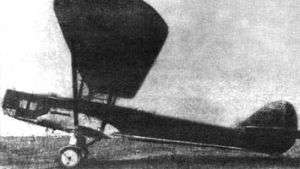Polikarpov TB-2
| TB-2 | |
|---|---|
 | |
| Role | Bomber |
| National origin | Soviet Union |
| Manufacturer | Polikarpov |
| First flight | 1930 |
| Number built | 1 |
The Polikarpov TB-2 (Russian: Поликарпов ТБ-2) was a Soviet heavy bomber prototype designed and tested in the 1920s. It was a sesquiplane of wooden construction, with engines mounted on the bottom wing. Work on the sole prototype began in 1927 and it was tested in 1930. Although TB-2 performance was superior to that of the Tupolev TB-1 in service at the time, it was deemed insufficient for 1930 and the project was abandoned.[1]
Specifications (TB-2)
Data from Shavrov 1985[1]
General characteristics
- Crew: five
- Length: 17.6 m (57 ft 9 in)
- Wingspan: 27 m (88 ft 7 in)
- Height: ()
- Wing area: 128 m² (1377.8 sq ft)
- Empty weight: 4,220 kg (9,304 lb)
- Loaded weight: 6,770 kg (14,925 lb)
- Powerplant: 2 × BMW VI V-12 water-cooled piston engines, 373 kW (500 hp) each
Performance
- Maximum speed: 216 km/h (117 knots, 134 mph)
- Range: 1,200 km (648 nmi, 746 mi)
- Service ceiling: 6,800 m (22,310 ft)
- Wing loading: 53 kg/m² (11 lb/(sq ft))
- Power/mass: 110 W/kg (0.07 hp/lb)
- Time to altitude: 12 min to 3,000 m (9,840 ft)
- Horizontal turn time: 26 s
- Takeoff roll: 210 m (688 ft)
- Landing roll: 180 m (590 ft)
References
| Wikimedia Commons has media related to Polikarpov TB-2. |
This article is issued from
Wikipedia.
The text is licensed under Creative Commons - Attribution - Sharealike.
Additional terms may apply for the media files.